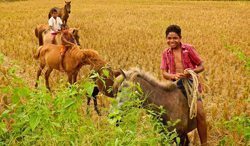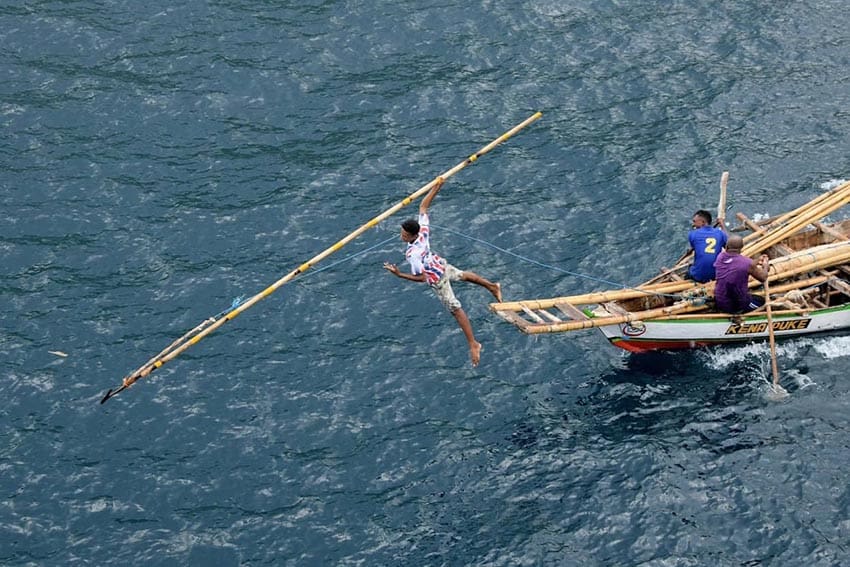
Journeys with the Caterpillar: Travelling through Flores and Sumba, Indonesia
By Shivaji Das
Excerpt from the ebook: Sacrifices at a funeral in Sumba
The crowd lined up along the street, shoulder to shoulder, back to front. Fathers held up their boys over their shoulders. The older children climbed up the trees to have a better view.
The pressure of the crowd was building behind me. On the other side, an opening formed in the crowd and about fifteen men assembled around the buffalo tied at the very end. We were on the remote island of Sumba, Indonesia, invited to witness the funeral rites for a hundred-year-old woman.
The crowd began pulling the buffalo towards the road. The women began yelling. Men broke ranks to give a push to the buffalo to prod it along. Some took a bamboo to beat it on its back. The hapless animal obliged and ran as directed. It was positioned on the road, right in front of the house.

The crowd quickly formed a circle around it. The buffalo swung its head to both sides to make sense of things and then the world came to a still. Nothing moved and no one said anything.I felt as if the whole world radiated from where the buffalo was standing.
In Sumbanese society, where ancestors are revered a lot more than living beings, death is the moment when a man finally gets his or her moment of glory. Death is after all the point of escape from the world of common insignificance to the elevated world of Marapu, a few steps closer to God in the Sumbanese system of their ancient animist religion.
So people spend great fortunes to build tombs and organize big feasts to commemorate the burials.
Death is also the moment when social ties are audited again by evaluating the gifts received from relatives and friends, usually in the form of buffaloes or pigs for sacrifice. It is the most important opportunity for the households to announce their social standing and therefore is not to be taken lightly.
The grander the tomb and the ceremonies, the stronger the message sent about the sponsor’s social standing.
Near Waikabubak
In this village near the town of Waikabubak in Western Sumba, everyone was watching the buffalo in silent anticipation. By now, the buffalo had calmed down and it lowered its head to search for grass on the road; its tail began to wave again. Then a man with an uncovered machete or parang slowly walked up to its side.
But the buffalo had taken to trust humans who had been taking care of it well this far. Desmond, the village head, began giving me live commentary. He explained that only the very best and experienced would be allowed to strike the buffalo with the parang. It was risky. What if the blow cut the rope instead?
The released buffalo could then maul many to the ground even killing the young ones. What if he hit the horns instead? That would be very humiliating for the person? There has to be a nice clean strike, straight at the jugular, that hung like a thick and flabby curtain from the buffalo’s stiff neck. Such a powerful animal with such a vulnerable throat!

Earlier in the day, visitors had kept pouring in. By two past noon, over two hundred people had gathered. Relatives and close friends of the family of the deceased had brought in four pigs and seven buffaloes, each of their arrival greeted by mock battle gestures by the men and elegant swinging dance by the females.
All the buffaloes had magnificent red turbans with overflowing sideburns. The largest of them stood out from the rest; it was of a pinkish hue compared to the grey of the rest, a buffalo that has a special significance in such funeral rites.
And so did the man in charge, a quick blow, right on the jugular and he withdrew back into the crowd. People began shouting, “watch out!” A misty fountain of blood was oozing out. And then there was a drain of blood, a small waterfall.
The buffalo took two seconds to realize what had happened. It pulled in one direction and many people joined in to pull the rope against it.
It tried to surge ahead and again people pulled the rope from both sides to keep it still. Four men moved forward and began jumping in front of it in one leg, brandishing their swords and making that squealing noise, “ka, ka, ka, ka, ka”.
The crowd around the buffalo had become fluid by now; moving left, forward, backward, right, following the movements of the wounded beast. It gasped for breath and blood kept gushing out in a mist. Desmond was following me, “take a picture now, did you get it, now, now, get a shot of its dying eyes!” A young girl squeezed her way to the front and stood beside me, holding her mobile phone to get a picture.
Everyone was taking pictures. Another man approached the buffalo to make a gash. The jumping and squealing men doubled their intensity, “kakakakaka”. People kept screaming and spitting the betel saliva mix. The coconut trees by the road, on top of which some children had positioned themselves for the view, were swaying from the movements of the crowd, dangling the children with them. The buffalo fell on its front knees.
The road in front had turned red and wet. The crowd parted suddenly to make way for a passing motorcycle. As they circled the buffalo again, it had fallen dead. It was quickly dragged away from the road to bring in the next one for sacrifice. The flies that had been circling it all its life finally got the chance to dig into its meat.
Seven other buffaloes are slaughtered before the dead body was finally placed in a tomb. Sumbanese tombs look like stone vaults with four walls and a tabletop. The stone at the top is often decorated with carvings of a buffalo head and its posterior as well as mamuli, the abstract symbol for male and female forces in Sumbanese culture.

A tomb may be shared by many family members but incest taboo is enforced strictly. So the dead children can never be kept together with their parent’s bodies while it is possible to bury them together with grandparents.
It is also common for the rich and mighty to build tombs for themselves in advance. All along western Sumba, one can see these megalithic tombs, some dating to over five hundred years ago, with patches of algae growth over them.
Desmond came in to explain, “We believe that the blood spilled in front of the house of the deceased makes smooth her passage to heaven. The slaughtered animals will actually join the dead in heaven. Why else would we sacrifice these animals when we have spent our lives rearing them? We barely eat meat. It’s too precious and expensive to eat every day.
So we wait for the days of the feasts and the meat is shared with the whole community.”
As I went back to my hotel, I was thinking about the day, the blood, and the people we met. Was there any inner layer to the obvious conclusions one can draw from the Sumbanese rituals and their fights? The Sumbanese, at least the people who had assembled in the funeral, were extremely dignified, polite, gentle and respectful. They wanted to make us comfortable. They were curious to know more about us and the places we had come from.
Unlike many conservative societies, they didn’t look at us as immoral tourists, but as their guests who need to be respected.
There were too many layers to a Sumbanese, a visible layer, shaped from poverty and harsh weather, a penchant for visual displays of violence, a history of bloody communal fights, stiff and rigid norms of society, codified for ages, draining lives without pause; and then there were the same faces that put down all their armory, bravado and rigidity with the humblest of smiles, which they were ever ready to display, even if stained with a murky blood red, from the betel nut they chewed all day.

Shivaji Das is Author of Journeys with the caterpillar: Travelling through the mystical islands of Flores and Sumba, Indonesia
Book available for download at http://goo.gl/h8eui
- Shhh, Keep Quiet About Queretaro - September 30, 2024
- Wroclaw Poland: A City Full of Dwarfs - September 25, 2024
- Hoi An–A City Frozen in Time - September 19, 2024





